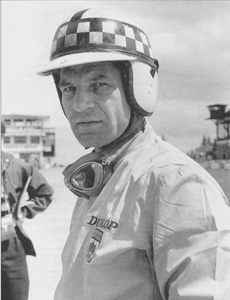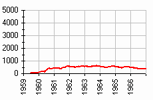Гонщики, I |
Ireland, Innes |
| Иннес АйрлендIreland, Innes |
 (c) 'Who is Who' by Steve Small, 2000 Родился: 12.06.1930 Майтолройд, Тодморден, Йоркшир Умер: 22.10.1993 Ридинг, Беркшир Сезонов в Ф1: Лет в Ф1: 8 Гран При: Старты: 50* *не стартовал: 10 Победы: - подряд: Подиумы: - подряд: Поул-позиции: - подряд: Первый ряд: - подряд: Быстрые круги: - подряд: Лучший финиш: Лучший старт: 2 Дубли: Хет-трики: Лидирование старт/финиш: Большие шлемы: Круги: - лидирования: 43 Километры: - лидирования: |
Год | Команда | Шасси |
It was all-change; the front-engined cars were out, as was the casual racing attire and devil-may-care attitude, but Innes carried the spirit of a fast-disappearing age into the sixties and in career terms it was to cost him dear.
The son of a veterinary surgeon, he showed no inclination to follow the same path and instead took up an engineering apprenticeship. After dabbling in racing between 1952 and 1955, a period which saw him complete his National Service as a paratrooper, Innes really got his racing career into gear with a Lotus XI in 1956. He began to build his reputation in 1957 and 1958, racing both his own car and the Ecurie Ecosse Jaguar D-Type. A class win in the Lotus at the Reims 12 Hours impressed Colin Chapman sufficiently for him to sign Innes for the 1959 season, and he took a fourth place in the International Trophy before making an impressive Grand Prix debut at Zandvoort. The cars were very unreliable, and little else was achieved until the 1960 season when the new rear-engined Lotus 18 proved sensationally quick. On its debut in Argentina, Ireland led comfortably until the gear linkage broke, and then at home he stormed to victory in the Glover Trophy at Goodwood, ahead of Moss, and the International Trophy, putting Brabham in his place. Although a Grand Prix victory was not to be his that season, Innes enjoyed a fabulous year, for in addition to the wins previously mentioned he took the Lombank Trophy and recorded some excellent placings as well as Formula 2 wins at Goodwood and Oulton Park.
The 1961 season started badly for Innes with a heavy crash at Monaco when he selected the wrong gear, but despite a fractured kneecap he was soon back in his stride, producing a splendid performance to win the Solitude GP, followed by a win in the Flugplatzrennen at Zeltweg. His great moment arrived at the end of the season when he won the US GP after a text book drive. Much to his chagrin, Ireland was then released from his contract by Chapman, who had decided that youngsters Jim Clark and Trevor Taylor would race for him in 1962. It was effectively the end of Innes' front-line career. Joining the UDT-Laystall team, he found success in sports cars, winning the Tourist Trophy in a 250 GTO, but endured a largely frustrating time in single-seaters. He won the Crystal Palace Trophy in 1962 and the following season (the team having been renamed BRP) he enjoyed a respectable early-season run in non-championship events with both a Lotus 24 and the team's own BRP chassis, winning the Glover Trophy and finishing third at Snetterton, second at Aintree, fourth at Silverstone and third at Solitude, before an accident at Seattle left him with a dislocated hip.
In 1964 Innes plugged away with the disappointing BRP, claiming a victory in the Daily Mirror Trophy at Snetterton, but the team closed its doors at the end of the year, leaving Ireland to find a berth in the Parnell Racing team for 1965. His off-track popularity was as high as ever, but sadly he was by then less than reliable as a driver. Appearing late for a practice session in Mexico saw him dismissed on the spot, but Tim Parnell must have forgiven him as he raced for the team again in the 1966 South African GP! Innes then found employment racing sports cars, sharing a Ford GT40 with Amon to take fifth place in the Spa 1000 Km. He drew down the curtain on his single-seater career late in 1966 when he joined Bernard White's suitably 'happy-go-lucky equipe and took fourth place in the Gold Cup at Oulton Park, before his last two Grand Prix appearances in the US and Mexico. His hell-raising lifestyle had not fitted in with the new professionalism of the age, but this unique character, who could both charm and outrage in short order, continued to be happily associated with the sport in both journalistic and organisational capacities on and off until his death from cancer in 1993.
(c) 'Who is Who' by Steve Small, 2000
| © WildSoft, 1995-2020 |


